Scott Hamilton – 14 January, 2014
What has been lost, in all the discussion about the unaffordability of first homes and the size rates rises, is an appreciation of the necessity of hard, modestly rewarded physical labour to the housing sector. Vea's installation reminded us that, while real estate agents pocket swollen commissions and contractors haul in profits, men and women, many of them Pacific Islanders, squat in the trenches and rubble of a thousand building sites, day after day, stacking bricks and pouring plaster.
In May 1870, a ship named the Lulu arrived at the port of Auckland, carrying twenty-seven adult males from the New Hebridean island of Efate. The passengers had been acquired at the request of Auckland businessman Edward Brissenden, who put them to work in a flax mill and on his St Heliers estate.
The Efateans’ presence did not go unnoticed by the city’s media. In an editorial published days after the arrival of the Lulu, the New Zealand Herald pointed out that ‘these niggers are entirely in the hands of their contractors’, and claimed that ‘experience and common sense’ suggested that the men were not in Auckland voluntarily.
At the same time that the Lulu was carrying its passengers south to Auckland, other vessels were bringing men to the plantations and mills of Queensland, Fiji, and Tahiti. In the second half of the nineteenth century, tens of thousands of Pacific Islanders were shipped out of their homelands and put to work for palangi businessmen. After toiling for years, the islanders were deemed to have fulfilled ‘contracts’ with their employers, and were returned home with a few goods, like metal axes and - sometimes - rifles.
Little sign of the transient labourers of the nineteenth century remains. Pacific Islanders virtually built Queensland’s vast and vastly profitable sugar industry, but when the archaeologist Lincoln Hayes went looking a decade ago for sites associated with them he could find only a few faint traces of the foundations of the rough barracks in which they had lived. No plaque remembers the slaves Edward Brissenden brought to Auckland.
In the twenty-first century Pacific Islanders are once again travelling to New Zealand on temporary work contracts. Since it was established in 2007, the Recognised Seasonal Employment scheme has brought Tongans to Nelson, where they pick apples, I-Kiribati to the green margins of Auckland, where they sweat over tomatoes and courgettes in vast glasshouses, and ni-Vanuatu to the apricot orchards of cold central Otago. These workers are paid the minimum wage of their host country, but are unable to spend most of the money they have earned until they return home. They are often given barracks-like accomodation, and their behaviour is carefully monitored.
Like their nineteenth century predecessors, the new migrant labourers are difficult for palangi to conceptualise. They have left behind societies where small-scale farming, often on communally owned land, is the dominant pursuit, and where the cash economy is usually less important than traditional family and tribal networks of exchange. They have become wage earners, but they will not be assimilated into the modern capitalist economies of Australasia. Instead, they will return to their villages and gardens. Many returning labourers use their savings to improve their family home, or to buy machinery for their plantation. School and church funds benefit from the cash of returning workers.
The new migrant workers cannot easily be counted as either members of the Western working class or as inhabitants of traditional, pre-capitalist societies. They occupy a sort of twilight space between economies and cultural codes.
In his famous essay ‘Our Sea of Islands’ the anthropologist and novelist Epeli Hau’ofa celebrated the movement of Pacific peoples across the world in the era of jet aircraft. Hau’ofa argued that the Samoan or Tongan who flies off to work in Los Angeles or Auckland is replicating the epic journeys that his or her ancestors made by vaka to distant parts of Oceania.
But ‘Our Sea of Islands’ has sometimes been criticised for its ebullience. Hau’ofa’s romantic rhetoric might seem inappropriate when we remember that Pacific Island migrants are typically overworked and underpaid by their hosts, and that their contributions to the prosperity of the West are often ignored.
In a recent exhibition called Homage to the Hoi Polloi, the young Tongan-New Zealand artist John Vea considered the experiences of migrant labourers, and tried to suggest their value to New Zealand’s economy.
In a performance that coincided with the opening of his show, Vea and some friends placed scores of cone-shaped lumps of plaster on the street outside the Papakura Art Gallery. More lumps were stacked together in wooden crates inside one of the gallery’s rooms.
Vea called his lumps of plaster ‘urban taros’. Shaped and sized like taro, a staple food and frequent item of exchange in Tonga and many other tropical Pacific societies, they were made from a material traditionally alien to the Pacific.
In a thoughtful essay printed to accompany Vea’s exhibition, Iona Gordon-Smith suggested that the urban taro were ‘ghostly impressions’ intended to ‘give visibility to mystery movements’. They might, perhaps, be likened to the foundations of long-razed barracks that Lincoln Hayes discovered on the edges of Queensland’s oldest sugar plantations.
But another, more straightforwardly political, interpretation of Vea’s strange crop was possible.
In the complicated charts of his works of political economy as well as the slogans of his pamphlets, Karl Marx argued that unpaid labour is the source of the wealth of capitalist society. ‘The rich are rich’, Marx insisted in a famous passage, ‘because the poor are poor’. The mansions and estates and art collections of capitalists like Edward Brissenden were intended, often, to inspire envy, but these possessions were only proof, Marx claimed, of larceny, like the petty burglar’s bagful of jewellery and cash.
It is easy enough for the rich to display their wealth, but how can workers conjure the riches that have been stolen from them? Vea’s urban taros could be considered tokens of the riches generated by and taken from migrant Pacific labour. Rather than embodying wealth, like the playthings of capitalists, the urban taros were intentionally valueless and drab. They were an absence made present.
In a video installation called Finish this week off, and that’s it! Vea found an eloquently simple way to describe the physical endurance required of many migrant workers. The video showed Vea dressed as a construction worker, striving to hold a large rock above his head. Again and again, Vea faded from the screen.
Finish this week off, and that’s it! might remind us of Gustave Courbet’s great painting The Stone Breakers, which shows a peasant road-building gang attacking a boulder with a pick. Working in 1849, the year after Marx published his Communist Manifesto, Courbet bewildered the privileged patrons of Parisian art by treating manual labourers with the sort of reverence that his peers reserved for mythological heroes and conquering generals. Vea’s tribute to manual migrant labour might be similarly perplexing to the burghers of modern Auckland.
In recent years Auckland’s media and politicians talked often about the city’s housing boom, which has seen prices rising intemperately and building contractors struggling to cope with the demand for new residences. What has been lost, in all the discussion about the unaffordability of first homes and the size rates rises, is an appreciation of the necessity of hard, modestly rewarded physical labour to the housing sector. Vea’s installation reminded us that, while real estate agents pocket swollen commissions and contractors haul in profits, men and women, many of them Pacific Islanders, squat in the trenches and rubble of a thousand building sites, day after day, stacking bricks and pouring plaster.
The third work in Vea’s exhibition was also concerned with construction. On a low wall of breezeblock concrete erected near the middle of a room of the gallery, a film showing the artist stooped in the waters of West Auckland’s Piha Beach played. As Piha’s legendary surf rolled in, Vea laboured to place one block of concrete on top of another. Finally, after the waves had performed a number of demolition jobs, Vea was able to create a modest wall.
As its title makes clear, 29.09.2009 Tribute to Samoa, American Samoa, and Tonga refers to the tsunami that struck Western Polynesia in September 2009, and to the struggle to rebuild the villages of islands like Niuatoputapu and ‘Upolu. But Vea’s performance piece could also be related to his interest in migrant Pacific labour.
Because of its cheapness and solidity, breezeblock is a popular building material in Samoa and Tonga, where traditional, circular fale that rely upon thatched roves and walls of wood or tapa are being superseded by rectangular or square Western-style homes. The breezeblock dwellings are sometimes derided by palangi tourists, who have been made familiar with the old fale by tourist brochures and postcards, but concrete embodies, for many of its Tongan and Samoan enthusiasts, the hope for a more prosperous life and higher social status.
In 29.09.2009 Tribute to Samoa, American Samoa, and Tonga Vea once again cast himself as a construction worker, but this time he chose to toil on Auckland’s West Coast, a region that has been celebrated and allegorized by generations of palangi artists.
The poems of Allen Curnow, the paintings of Colin McCahon, Don Binney, and John Madden, and Jane Campion’s film The Piano all make the West Coast into a symbol of New Zealand identity. In Campion’s film and some of Curnow’s greatest poems, the beaches of the west become the site where New Zealand encounters the outside world, as alien objects like a grand piano crafted in Europe or a Japanese fisherman’s float are washed onto the borders of the local and the primeval.
During World War Two, the West Coast was the scene of desperate activity, as members of a hurriedly mustered Home Guard cut tracks through bush and laid tank traps in preparation for a Japanese invasion. In recent years, the beaches of Auckland’s west have been sites for nationalistic protests against plans for the mining of oil and iron sand by Chinese and Brazilian companies.
There is irony in John Vea’s attempt to hold off the alien world that supposedly lurks off Auckland’s West Coast. As a Pacific Islander, he is, after all, a member of a community that has historically been viewed with suspicion by xenophobic palangi Kiwis. (In the 1970s, Auckland’s Police Commissioner warned Pacific Islanders who ‘didn’t look like New Zealanders’ to keep their passports or work visas with them at all times; a few years later neo-Nazis distributed leaflets on the streets of Auckland calling for the mass deportation of Pacific Islanders, and warning about the dangers of a ‘mongrel race’ emerging from marriages between Pacific and palangi Kiwis; in 2000 the leader of the National Party had to apologise after describing Pacific Islanders as people who “climb through the windows of other New Zealanders at night”.)
With its fragile, provisional nature and its Pacific Island designer, Vea’s breezeblock wall could have been considered a gentle satire of attempts to make the West Coast into a bulwark of New Zealand identity. The wall might also be interpreted as an acknowledgement of the fragile, provisional nature of the communities formed in this country by Pacific Island migrants.
Scott Hamilton
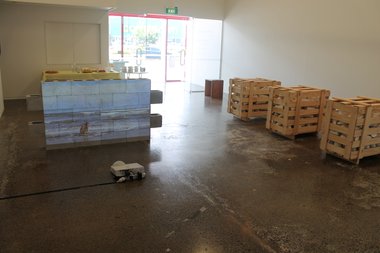
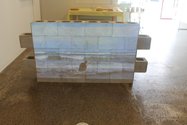
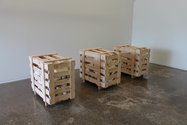
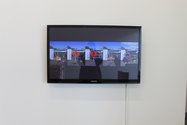
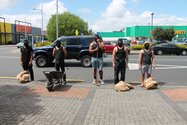
 Two Rooms presents a program of residencies and projects
Two Rooms presents a program of residencies and projects Advertising in this column
Advertising in this column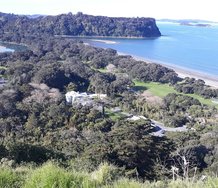
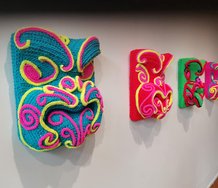

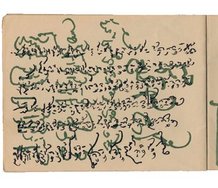
This Discussion has 0 comments.
Comment
Participate
Register to Participate.
Sign in
Sign in to an existing account.